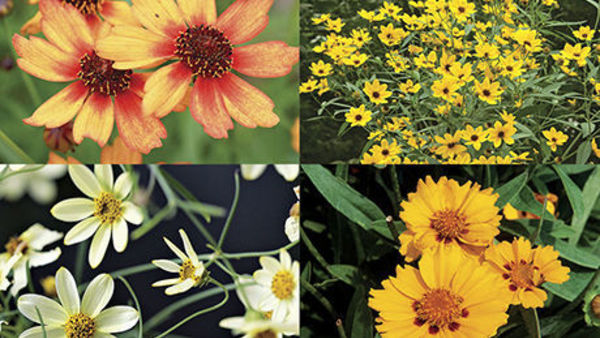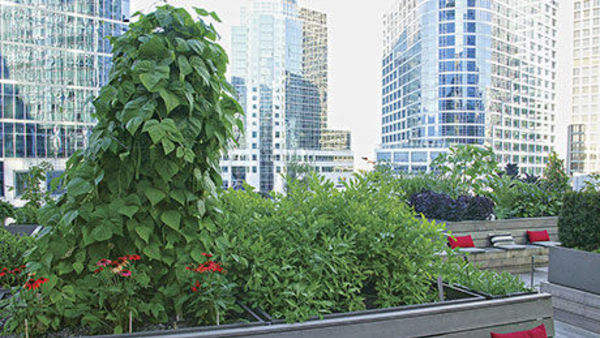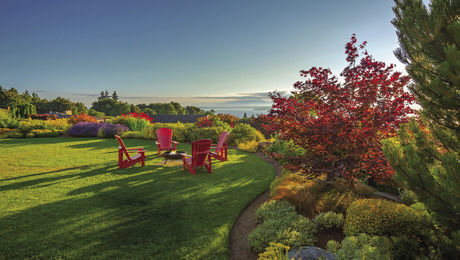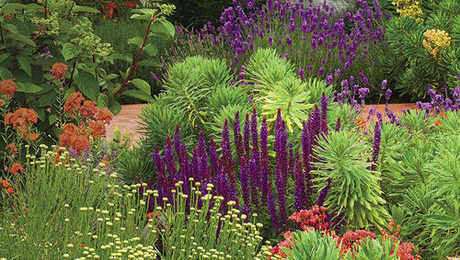
In a world full of glorious color, why limit oneself to just two when designing containers? Because limitations can be . . . liberating. Color is so seductive that it fools us into ignoring the other elements of design, texture, and form. We pig out on color, only to find that a diet of color alone is as unsatisfying as a diet consisting solely of dessert. Eventually, we want something more substantial, something more satisfying.
By committing to a limited palette, we begin to appreciate the way each plant must bring something more to the table: the way the right plant makes every one of its neighbors look better; the way all of the elements working together create a richer tapestry than is possible with color alone. We still get color, but we get nuance, we get satisfaction, and we can’t wait to do it again.
Violet & Silver

This moody combination relies on contrast between light and dark to create plenty of visual interest from just a slice of the color palette. The petunia flower itself contains all of the colors in the final combination—the surrounding plants each echo an aspect of a single blossom to create a harmonious whole.
- Violet Intrigue lavender (Lavendula angustifolia ‘Lavang 21’, USDA Hardiness Zones 5–9)
- ‘Goldcrest’ lemon cypress (Cupressus macrocarpa ‘Goldcrest’, Zones 7–9)
- ‘Icicles’ licorice plant (Helichrysum thianschanicum ‘Icicles’, Zones 9–10)
- ‘Blackie’ sweet potato vine (Ipomoea batatas ‘Blackie’, Zone 11)
- ‘Quicksilver’ hebe (Hebe pimeleoides ‘Quicksilver’, Zones 8–11)
- ‘Limelight’ licorice plant (Helichrysum petiolare ‘Limelight’, Zones 10–11)
- Moonlight Eclipse™ petunia (Petunia ‘Kumiyama 1 Gou’, annual)
- ‘Amethyst Improved’ basil (Ocimum basilicum ‘Amethyst Improved’, annual)
Chocolate & Lemon

The pot is an essential part of any color palette. This rustic brown stoneware is an excellent foil for alternating chocolate and gold foliage, while the green separates the colors in key areas. The New Zealand flax and the dahlia contain all of the colors in the final palette. Bright golden flowers keep the mood light.
- ‘Alison Blackman’ New Zealand flax(Phormium ‘Alison Blackman’, Zones 8–11)
- ‘Sunshine’ Chinese ligustrum (Ligustrum sinense* ‘Sunshine’, Zones 6–10)
- ‘Alumia Vanilla Cream’ marigold (Tagetes patula ‘Alumia Vanilla Cream’, annual)
- ‘Dark Angels Taxi Driver’ dahlia (Dahlia ‘Dark Angels Taxi Driver’, Zones 8–11)
- Golden creeping Jenny (Lysimachia nummularia* ‘Aurea’, Zones 4–8) in spring
- ‘Moonraker’ cape fuchsia (Phygelius × rectus ‘Moonraker’, Zones 7–9)
- ‘Black Scallop’ bugleweed (Ajuga reptans ‘Black Scallop’, Zones 3–9)
Burgundy & Cream

Minimal doses of green serve to soften this unusual palette. Four varying shades of burgundy are presented in four different forms and textures to keep it interesting. Adding deep burgundy hues amps up the drama.
- ‘Mahogany Splendor’ hibiscus (Hibiscus acetosella ‘Mahogany Splendor’, Zones 8–9)
- ‘Red Riding Hood’ penstemon (Penstemon schmidel ‘Red Riding Hood’, Zones 5–9)
- Redhead coleus (Plectranthus scutellarioides ‘UFO646’, Zones 10–12)
- ‘Scarlett Marglin’ African boxwood (Myrsine africana ‘Scarlett Marglin’, Zones 9–11)
- ‘Blackie’ sweet potato vine (Ipomoea batatas ‘Blackie’, Zone 11)
- Easy Wave® Red Velour petunia (Petunia ‘PAS933560’, annual)
- Lanai® Lime Green verbena (Verbena ‘VEAZ0013’, Zones 9–11)
- Black mondo grass (Ophiopogon planiscapus ‘Nigrescens’, Zones 6–11)
Pink & White

Frosted curls sedge and ‘Silver Posie’ thyme are perfect harmonizers in almost any color scheme; they provide texture and a sparkling light green that makes companion colors look deeper and the dark greens richer. Without them, this combo loses movement, subtlety, and grace.
- Frosted curls sedge (Carex albula, Zones 7–10)
- ‘Repandens’ English yew (Taxus baccata ‘Repandens’, Zones 5–9)
- ‘Chaotic Rose’ coleus (Plectranthus scutellarioides ‘Chaotic Rose’, Zones 10–12)
- ‘Silver Posie’ thyme (Thymus ‘Silver Posie’, Zones 3–9)
- ‘Magellan Cherry’ zinnia (Zinnia elegans ‘Magellan Cherry’, Zones 10–12)
- Pops™ Pink + Red Eye verbena (Verbena ‘KLEVP15622’, annual)
- White bacopa (Sutera cordata cv., annual)
Rose & Lime

You don’t need a riot of color when you have a riot of texture. The bold-leaved Kong® coleus finds the ultimate contrast in the delicate foliage of the asparagus fern, while the mondo grass and moss provide light and dark, shiny and soft. Magenta blooms create a carefully coordinated focal point.
- ‘Soft Caress’ Oregon grape (Mahonia eurybracteata ‘Soft Caress’, Zones 7–9)
- Kong® Rose coleus (Plectranthus scutellarioides ‘Kakegama CE14’, Zones 11–12)
- Sunpatiens® Compact Royal Magenta (Impatiens ‘SAKIMP029’, Zones 10–11)
- Black mondo grass (Ophiopogon planiscapus ‘Nigrescens’, Zones 6–11)
- ‘Myersii’ asparagus fern (Asparagus densiflorus ‘Myersii’, Zones 9–11)
- Golden club moss (Selaginella kraussiana ‘Aurea’, Zones 7–9)
Advice for Better Combinations
Consider the color of your pot and exploit it. It’s a big piece of real estate and should be a harmonious part of your overall color scheme, even if it’s black or brown.

▸ Include very light and very dark elements in every design. They create a rich setting for your chosen colors. Sneak in some foliage in gold, silver, or black; these “non-colors” help add contrast without stealing the show.
▸ Don’t rely solely on annuals. Evergreens provide solidity and structure, which shows those annuals to best advantage. They also don’t require deadheading.
▸ Embrace unusual combinations. They often end up to be favorites.
Barbara Libner designs container plantings for Ravenna Gardens in Seattle.
Photos: Stephanie Fagan
Fine Gardening Recommended Products

Corona E-Grip Trowel
Fine Gardening receives a commission for items purchased through links on this site, including Amazon Associates and other affiliate advertising programs.

Gardener's Log Book from NYBG
Fine Gardening receives a commission for items purchased through links on this site, including Amazon Associates and other affiliate advertising programs.

Gardena 3103 Combisystem 12-Inch To 20-Inch Adjustable Metal Fan Rake Head
Fine Gardening receives a commission for items purchased through links on this site, including Amazon Associates and other affiliate advertising programs.



















Comments
Log in or create an account to post a comment.
Sign up Log in